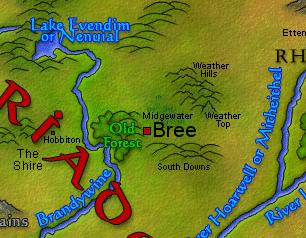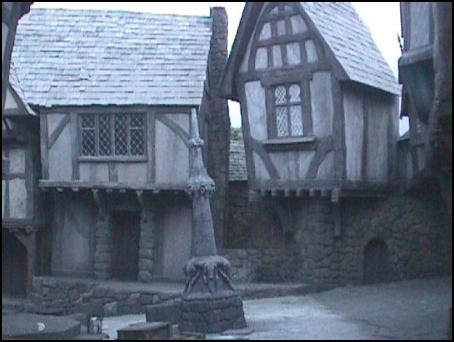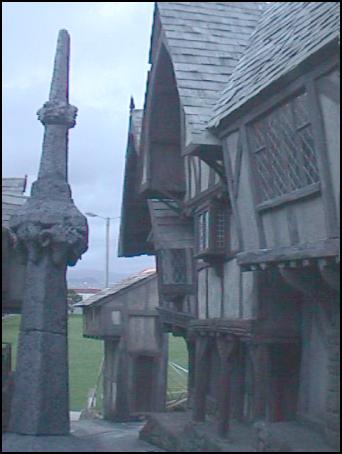|
|
|
![]()

Version 1.1 9/11/02

Reputedly founded during the Second Age of the Sun by Men from Dunland, Bree was the main village of Breeland (the others being Combe, Archet and Staddle). It was to be found at the crossing of the Great East Road and the North Road, which was to the east of the Shire and in the heartland of what was once the kingdom of Arnor, and was home to around one hundred Hobbits and Men. By the time of the War of the Ring, Bree was much diminished in size and importance from the great days of Arnor. However, considering the scale of destruction of Arnor at the hands of the Witch-king of Angmar, it is surprising that Bree survuved at all. This survival was no doubt due in part to the Rangers of the Norrth, and in part to its naturally stratedic position at the crossing if the two main trading routes. To many who travelled these roads, Bree was most famous for the Prancing Pony Inn, the region's most famous inn and most likely place to catch up on all the news and gossip from places both near and far.
Bree-land is a small, settled area in central Eriador that lies just to the east of the Tyrn Gorthad, the ancient Barrow-downs. The region has been almost continuously inhabited since the First Age. In T.A. 1640 Bree is not much different that it would be at the time of the War of the Ring some 1300 years later - a prosperous, quiet but sometimes threatened farming community standing near the intersection of the great East Road and the Greenway, the two major thoroughfares of the Kingdom of Arnor.
Bree-land is quite small and contains four villages within its boundaries: Bree, on the western slope of Bree Hill; Staddle, on the other side of the hill; Combe, a few miles to the east, and Archet, which lies a few miles northeast of Bree. The Chetwood, a goodsized but tame forest is also considered part of Bree-land and lies just north of Archet. The whole region is a generally pleasant, peaceful, and law-abiding spot where Men and Hobbits dwell together in peace, facing danger but rarely - unless one ventures to the Barrow-downs in search of gold and jewels, or is unfortunate enough to run into the bandits that plague the highways outside of Bree-land proper.
But the people of Bree-land generally ignore the haunted and foreboding Barrow-downs to the west. These grassy hills hold the graves of the Kings, Queens, Princes and aristocrats of Arnor. In the years after the Plague the mounds became haunted by evil spirits from Angmar and Rhudaur called Wights. The downs are rich in treasure and adventure, but it would be prudent for the adventurous to seek the council of the wise before trying their luck in the ancient and eerie tombs.
Bree-land has recovered well from the Plague, partially because it lies at the conjunction of the Greenway and the Great East Road. The town's location brought it commerce and immigrants that it needed to recuperate. Although somewhat diminished in size, the area is almost as prosperous as in the great days of Arnor a few centuries ago.
Travellers, soldiers, merchants, Dwarves, and caravans headed in every direction pass through Bree. Villagers regard these strangers with a friendly tolerance, ready to lend a helping hand or have a friendly chat in the inn. On the whole the influence of the commerce upon the character of the village is diffuse. Bree is prosperous, but retains its character as an agricultural community more interested in daily affairs than in the events of the wide world.
Yet in its own way, Bree is a lively place all year. Although it has grown colder of late, because of the malignant influence and power of the Witch-King of Angmar, heavy snows are rare, and the roads are well-travelled throughout the year. Dwarves frequently pass through Bree, journeying from Moria to their mines in the Ered Luin or travelling with trading expeditions to Arthedain's capital at Fornost. Certain Dwarves are actually quite familiar sights, since they regularly handle trade between the Dwarves and the men of Bree. Merchants and traders who do business in Arthedain and Gondor are also frequent visitors. Peddlars are seen most rarely; many of the small villages that supplied them their business were wiped out in the Plague.

The men of Bree gather at the inn called the Prancing Pony to hear the news and to talk with many strangers who travel the roads. Bree has an unusually large inn for a community its size, since the town is a convenient stopping point for travellers. It is, after all, at the chief crossroads of Eriador. Traffic through Bree has made its inhabitants less insular and more worldly than would ordinarily be true of residents of a typical rural settlement.
The peculiar location of Bree has accustomed its people to dealing with unusual situations and landing on their feet. It seems to be an inborn knack for Bree-landers to survive and to thrive. While many towns dissolved in the wars of the Second Age and the 1409 war against Angmar, Bree still remains peaceful, quiet and rural. Perhaps it is because of an unconscious ability of the Bree-landers to keep their settlement small and seemingly uninteresting to outsiders. Another reason may be the subtle protective influence of Gandalf the Grey and the diffused but still potent hand of Arthedain.
Bree-land is generally a quiet place, excitement being considered bad for the crops and the health of the inhabitants. People are generally law-abiding and friendly - with a few notable exceptions. Bree-land has an able guard and need not fear attack by marauding bandits who sometimes harass and rob travellers along the main roads. The town itself occasionally witnesses visits from the shady characters who prey on ignorant soldiers from Arthedain's nearby eastern frontier defenses or the varies complement of travellers, but these nefarious leeches are hardly the rule or even a noticeable problem. Crime to seems to favor the wilds.
Bree is about the same size in T.A. 1640 as it was and will be. the four villages that the original settlers established in the Second Age are still intact, rebuilt after the assault of Angmar, and the rare overcrowding that occurred in the late 1500's has been alleviated by the founding of the Shire and the subsequent Plague. Each village is small and consists primarily of farmhouses and cottages with a few craft shops.
Bree lies on the western slopes of Bree Hill. The hill shelters the town, and windows of the houses ordinarily face west and south to catch the afternoon sunlight. There are about one hundred houses in the village, most of them built above the road and set into the side of the hill. Because of this location, most of the gardens are on the southern and western sides, in front of the houses. The central road cuts through a small corner of the village, since it travels along the foot of the hill.
Most of the houses of Bree are built of honey-colored stone quarried a few miles away or taken from the remains of old forts to the south and west. These homes are solid and comfortable, like their inhabitants. Most of the houses have at least two stories, since the rear of the first story and part of the second are set into the hill. The orientation of the houses keeps them fairly warm and comfortable in the Winter, even if one uses only a fairly small amount of firewood. Since the houses are set into the hill, they make use of the earth' insulation. Thick, dry thatching brought from the nearby marshes keeps the homes warm in the Winter and cool in the Summer. Almost every house has a small barn attached to it, since most people tend animals, including hogs, chicken and a few cattle. Although this does little for the odor of the home, it does help to keep the house warm. On the whole the village is prosperous, its streets neat and orderly, and houses and yards are clean and well cared for.
Bree's streets are cobbled, and people take great care that sewage does not run freely. Sewage is commonly saved and used as fertilizer, since most villagers are farmers. Water is plentiful in the area; the town has several wells that are used and shared by the community.
Several families of Hobbits live on the upper slopes of Bree-hill, but the majority reside in Staddle. Bree's Hobbits have dug their small cozy smials parallel to the slope of the hill so that their holes get a maximum amount of sunlight. Most smials consist of a series of adjoining rooms with wide windows to catch the light. Many smials have several doors built for the convenience of the inhabitants. Quite often, Hobbits tend pretty, sloping gardens in front of the smials and keep their cattle and other animals in small sheds.
The men and Hobbits of Bree have close friendly relationships, often working together on various farm tasks. Commonly they trade off farm chores, men accomplishing a task better suited to a mannish height for a Hobbit-farmer, and vise versa. The Halflings' adept fingers are in particular demand in close quarters or where extreme dexterity is desired. Some of the mannish families even have Hobbit-sized chairs in their parlors; their children enjoy having their own crafted furniture.
Only the smaller farmers reside in the village proper, along with agricultural workers, guardsmen, and various craftsmen. There are no real commercial stores or shops in Bree, since everyone supplies his own needs or makes up the lack from the market held every two weeks. The village contains several craftsmen, including a weaver, a carpenter, a blacksmith, and a stone mason. A tanner and leatherworker has a roomy shop outside the town's walls.
Most farms are located outside the wall and hedge that protects Bree. the farmhouses
connected to these farms range dramatically in size from huge two-story affairs
that house the farmer, his family, his servants and his laborers to snug cottages
that hold a single small family. The farms of Bree-land are varied; some are
only a few acres while others encompass a hundred acres or more.

EAST OF THE BARROW-DOWNS the Hobbits came to Bree-land, a small country of fields and tamed woodlands only a few miles broad."' Bree-land had four villages: Bree, Staddle, Combe, and Archet. The settlements were clustered around the slopes of Bree-hill - Bree on the west, under the frowning hill-brow; Staddle on gentler south-eastern slopes; Combe in a valley on the eastern flanks; and Archet in the Chetwood north of Combe.' Of the four, the largest and most important was Bree. Tiny as it was, the little country had bent with the ebb and flow of many centuries, for it had been settled by Men of Dunland in the Elder Days. About 1300 the Big Folk had been joined by Hobbits fleeing Angmar and the Little Folk settled especially in Staddle, but there were also some in Bree.
The predominance of Bree probably stemmed from its location at the intersection of two major roads: the Great East Road and the old North Road. The latter had been most important during the early Third Age when the Dunedain passed between Fornost in the north down to Tharbad, and beyond to the realm of Gondor. After the fall of Arnor the road was seldom used and became known as the Greenway for it was grass-grown. The road-crossing was just west of Breehill, and as with many ancient settlements the Breemen had attempted to protect their village with physical obstructions. They built no walls, but dug a deep trench or dike with a thick hedge on the inner side. The Great East Road passed through the village, so a causeway was built across the dike at the Road's entry in the west and exit in the south. At the hedge the Road was blocked with sturdy gates, constantly tended.


Inside the village the Road curved south around the hill, then turned east again. A drawing shows a lane which curves north from the Great Road, one branch climbing to the crest of the hill, while another leads through a small opening in the hedge for a shorter route to Combe and Archet. In the same drawing the dike is shown as being almost semicircular. This gently sloping area was not nearly as popular as the hill of Bree, however, for most of the houses of Bree were built east of the Road, with few between there and the dike. The village held about a hundred stone houses, mostly on the lower slopes of the hill. East and above them were delved Hobbit-holes. Only four structures were specifically mentioned: lodges for the two gatekeepers, Bill Ferny's house (the last before the South-gate), and the excellent inn, the Prancing Pony.

Tolkien stated that bree meant "hill," a term appropriate for the locale; but it may also have been a dual play on words (although it was not mentioned). For bree is also Scottish for liquor or "broth" - both of which were served by Butterbur in large measure. Looking for some refreshments and a room for the night, the Hobbits rode to the inn. It stood where the Road began to turn east, yet was not far from the West-gate, for the Hobbits had passed only a few houses before reaching the yard. The windows the front faced west toward the Road, and two wings ran back into the hill, with a courtyard between the inn had three floors, there was an archway in the centre that permitted entrance to the courtyard supported the upper rooms. The Hobbits left their ponies in the yard, and Bob was sent to stable them - possibly on the ground level of the south which had no doors nor steps mentioned.

The inn was entered by climbing the broad steps left side under the arch. 15 Once inside Frodo almost collided with Butterbur, who was carrying a tray mugs "out of one door and in through another.” He was probably going from the kitchen to the Common room, which normally would have been close to the front-door for the convenience of the villagers. The innkeeper led the Hobbits down a short passage to “a nice little parlour.” It was small and cosy, had a fireplace, some chairs, and a table.

They were also shown to their rooms to wash These were apparently farther along the hall of north wing and may have been at the far end; for tucked against the rising hill there may not have enough space for a full-sized room, but only for small beds of Hobbits. The location was also supported by Strider's statement that the rooms' windows were close to the ground; and while steps were needed the front of the inn, in back the lower story actually shorter than the upper ones due to the rising slope. Those low-set windows were so unsafe the ranger wisely insisted the Hobbits spend the night in the parlour. The kitchen, a private dining room used by Gandalf (in an early version), Butterbur's chamber and a side door would also have been convenient placed on the ground floor.



About Us | Write for us
© 2002 Mithaearon. All rights reserved. Terms
of Use Privacy Policy
Comments? Questions? Feedback? Click here!